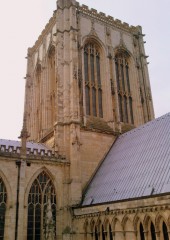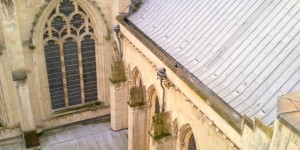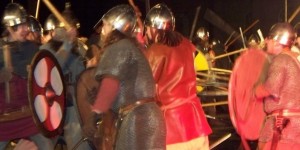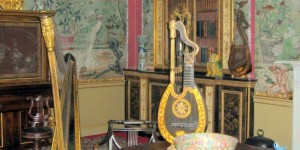Brighton and Hove (Brighton's next door neighbour), the home all of things cheerfully camp was a relatively small set of seaside fishing villages until the Georgian period, when with the arrival of George IV (the Prince Regent) thrust the area into the public spotlight and the town was reborn under the guise of a spa town.
The prince brought many rich aristocratic people down from London which established the town as a resort for the rich with disposable income. The town flourished once more in the late 1800's with the birth of the railways. The short time travelling from London down for the coast for a day trip appealed to the working class of London and the city grew once again as a tourist town.
In more recent times, the 1960s was another interesting period for Brighton, with the pilgrimages by Mods and Rockers to the beach almost every week. This most famously was shown in the film Quadraphenia. In 1984 during the Conservative party conference, the IRA tried to assassinate Margaret Thatcher, after attempting to blow up a section the famous Grand Hotel. The bomb went off killing 5 and injuring 31 but the then Prime Minister escaped harm.
Brighton and Hove gained city status in 2000 and is famous for its seaside atmosphere, dirty weekends and picturesque Georgian architecture. It has seen a great rise in tourists from the U.K and abroad and will continue to reap the benefits of this long and colourful history. It must be said that this lively town is not just for night out but is worth a visit at any time of the year.## Getting to Brighton (from York)By Car: Brighton is located right on the south coast, so head south taking the A64 to the M1, and continue on here until you get to the M25 and head clockwise. From the M25 take junction 7 on to the M23 and continue following this road down on the A27 all the way to Brighton.
By Train: It couldn't be any easier to get to Brighton on the train. From York, take any of the frequent trains down to London Kings Cross or St. Pancras. From Kings Cross you take the underground to London Victoria or from St. Pancras itself and from here get on any train to Brighton. These are once again very frequent and not too expensive.
By Coach: The best way to get to Brighton on the coach is from either getting the National Express service 561 from York to Brighton seafront or the Megabus from Leeds down to London. From here the number 025 heads to Brighton from London Victoria coach station.## AccommodationAs you expect with any bustling seaside city accommodation is frequent and ranges in standard. From the cheapest B&Bs to luxury seafront hotels (which will cost you a lot!) there is no shortage of places to stay. Best check out the Visit Brighton website for recommendations and price guides.
Alternatively you can crash at some local campsites; there are two within a close proximity to the city itself. These are Blackberry Wood or Sheepcote Valley (Caravan club). Brighton back-packers hotspot The Grapevine or hostels such as Seadragon or St. Christophers Inn provide excellent accommodation for not a lot of cash.## Places to visit
- Museums
- Royal Pavillion: Brighton's most famous building, built by the Prince Regent as his holiday home by the sea. Designed by John Nash and built between 1815 and 1822, it recently had a ?10million restoration project, guides available in English, French, German, Mandarin, Cantonese and Italian. Expensive but worth it just to see the elaborate 34 course dining table and interior décor to blow Lawrence Llewellyn-Bowen away! Entry costs, ?8.30 adult, ?6.40 concession, ?5.00 children.
- Brighton Museum and Art Gallery: Brighton's main museum, located in the grounds of the Royal Pavillion houses exhibitions on Brighton's history, the history of furniture and design, a small Egyptology section and a near permanent 1960s exhibition. Entry is free and definitely worth a visit
- Hove Museum: A fantastic small museum on the Hove seafront, houses a number of small exhibits with one permanent one about children and childhood in general. Once again entry is free, but can be hard to find the museum. Go if you can find it, the grounds of the museum contains a pagoda given to Brighton from the Indian viceroy in the 1940s.
- Brighton Toy Museum: Independent museum located under Brighton train station, it houses thousands of toys and is definitely worth a visit. Entry costs ?4.00 adults, students and children ?3.00
- The Booth Museum of Natural History: Massive collection of stuffed animals, a bit morbid but can teach you about evolution and you get to see many species of animals you can see on the TV!
- Preston Manor: A Victorian manor house, this attraction is a fully restored period house with all the fixtures and fittings you would expect from a Victorian house. Worth a trip, entry costs ?4.10 adults, ?2.40 children.
- Other attractions
- The Volk's Railway: The first electric railway in Britain, runs along the seafront however is seasonal in its opening times.
- Brighton Pier: No trip to the seaside would be complete without getting your lips round some candy floss and going on one of Brighton's most popular tourist trap, I mean magnet.
- The Lanes: Shopping galore, hundreds of little boutiques with all kinds of kitsch items to buy, bargains are guaranteed.
- Brighton Sea Life Centre: One of the oldest aquariums in the country and has recently brought in new displays and a menagerie of sea creatures.
- The West Pier: Fire, storms and seagulls have all taken their toll on this once proud pier. Abandoned in the 1960s it was left to rot. Fire ravaged the pier in 2004 and then storms took their toll on the structure, now its mostly poles sticking out of the sea. Plans to develop and restore the pier are in the pipeline, and the old girl may have some action left.
- The Dome: Once the stables for the Royal Pavillion, this stylish building now houses the city's premier theatre and music venue. No massive bands perform here; it works best as an intimate venue. Inside is a stylish bar area but is only open to ticket holders to one of the shows.
- Places close by
- Lewes: Take a trip to Lewes, the county town of East Sussex, home to a pre-Norman castle, a famous bonfire night festival and fantastic local brewery, easy to get to and a fantastic place to visit. It is located to the east of Brighton, easy to get to by car or train.
- Arundel: Once again a close by is another very old town, located to the west of the city. Home to a couple of stately homes and a fantastic castle, this market town is worth a visit and some of the local produce (and beer) on display should wet your appetite.
- Eastbourne: Ahh the pensioner capital of England, is similar to Brighton in the age of its expansion with the same architecture with similar attractions. Further away along the east coast, but worth the drive to see, are the wonderful seven sisters, which guard Sussex coast from the dangers of the English Channel.
Further Details
- Brighton Tourist information: tel 0906 711 2255
- Visit Brighton
- Brighton & Hove archaeology Society










